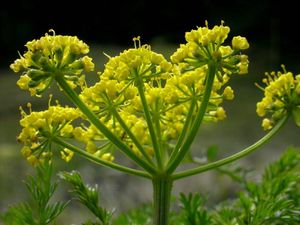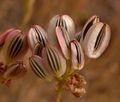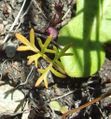Lomatium utriculatum
- Latin Name: Lomatium utriculatum
- Family: Apiaceae
- Common Names: common biscuit-root, bladder desert-parsley, spring-gold
- Synonyms/Misapplications: Lomatium vaseyi
- Codon: LOMUTR
Contents
Taxonomy
| Scientific classification | |
|---|---|
| Kingdom: | Plantae |
| Subkingdom: | Viridiplantae |
| Phylum: | Tracheophyta |
| Subphylum: | Spermatophytina |
| Class: | Magnoliopsida |
| Subclass: | Asteranae |
| Order: | Apiales |
| Family: | Apiaceae |
| Genus: | Lomatium Raf. |
| Species: | Lomatium utriculatum (Nutt. ex Torr. & A. Gray) J.M. Coult & Rose |
| Synonyms | |
| |
Plant Description
For the Lomatium genus, mature fruit shape, aspect ratio, and pedicel length are diagnostic.[2]
Native perennial taprooted herb, up to 6 dm tall.[3]
Leaves are lacy, pinnately to ternately-pinnately dissected, with inflated leaf sheaths, strongly caulescent.[3][2]
Flowers arranged in compact compound umbels[3], corolla yellow, pedicels 2-5 m. Involucre lacking, at base of compound umbel, but involucel, at base of each umbellet, present, slightly to strongly toothed.[2]
Fruit dorsally ribbed,[2] oil tubes 1-4 per rib interval.[4]
Bloom Period
April-June. [5]
Distribution
West Cascades, southern BC southward to southern California.[2]
Habitat
Low elevations, in open, rocky meadows and slopes, often growing with grasses.[3]
Uses
Atseguwi use of leaves as food.
Kawaiisu use of leaves and flowers, fried in fat, as food, and a decoction as a wash for broken limbs.
Salish use of roots, chewed or soaked in water, for headache or stomach issues.[6]
Propagation
Seeds are most easily sown as soon as they are ripe in a cold frame as stored, as seed can be rather slow to germinate.
When sown in the spring it usually takes at least 12 months to germinate, although this time most might be reduced by cold stratification.
Fresh seed can be sown immediately in site. Division may be possible in spring or autumn.[7]
Seed
Seed sample from: 2011
Average Measurement: 5.7 x 3.2 x 0.5
Measurement Range: L: 5.25 – 6.5, W: 2.5 – 4, D: 0.25 – 0.6
Features
Shape: Seeds schizoid, very flat and winged. Hilum and opposite apex are narrower than middle of seed.
Color: Inner seed face is dark reddish brown, with off-white wings. Hilum is tan.
Surface: Three off-white ridges run longitudinally across dark seed face. On opposite seed face, one off-white ridge bisects dark seed face from hilum to opposite apex. In most seeds, two shorter and lest distinct white markings run parallel to the main white ridge. Seed smooth and somewhat iridescent.
Latitudinal Cross Section: elliptical 
Longitudinal Cross Section: elliptical ![]()
Photo Gallery
References
- ↑ Integrated Taxonomic Information System. Retrieved from https://www.itis.gov/servlet/SingleRpt/SingleRpt?search_topic=TSN&search_value=29756
- ↑ 2.0 2.1 2.2 2.3 2.4 Hitchcock, C. L., Cronquist, A., Giblin, D., & Legler, B. et al. (2018). Flora of the Pacific Northwest: an illustrated manual. Seattle: University of Washington Press.
- ↑ 3.0 3.1 3.2 3.3 Bowcutt, F., & Hamman, Sarah. (2016). Vascular plants of the South Sound prairies (First ed.). Olympia, Washington: The Evergreen State College Press.
- ↑ Lincoln Constance & Margriet Wetherwax 2017, Lomatium utriculatum, in Jepson Flora Project (eds.) Jepson eFlora, Revision 5, /eflora/eflora_display.php?tid=31473, accessed on June 08, 2020.
- ↑ WTU Herbarium, Burke Museum, & University of Washington. Retrieved from https://biology.burke.washington.edu/herbarium/imagecollection/taxon.php?Taxon=Lomatium%20utriculatum
- ↑ Native American Ethnobotany Database. Retrieved from http://naeb.brit.org/uses/search/?string=Lomatium+utriculatum
- ↑ Lomatium utriculatum - (Nutt.)Coult.&Rose. Lomatium utriculatum Common Lomatium PFAF Plant Database. https://pfaf.org/user/Plant.aspx?LatinName=Lomatium+utriculatum.





